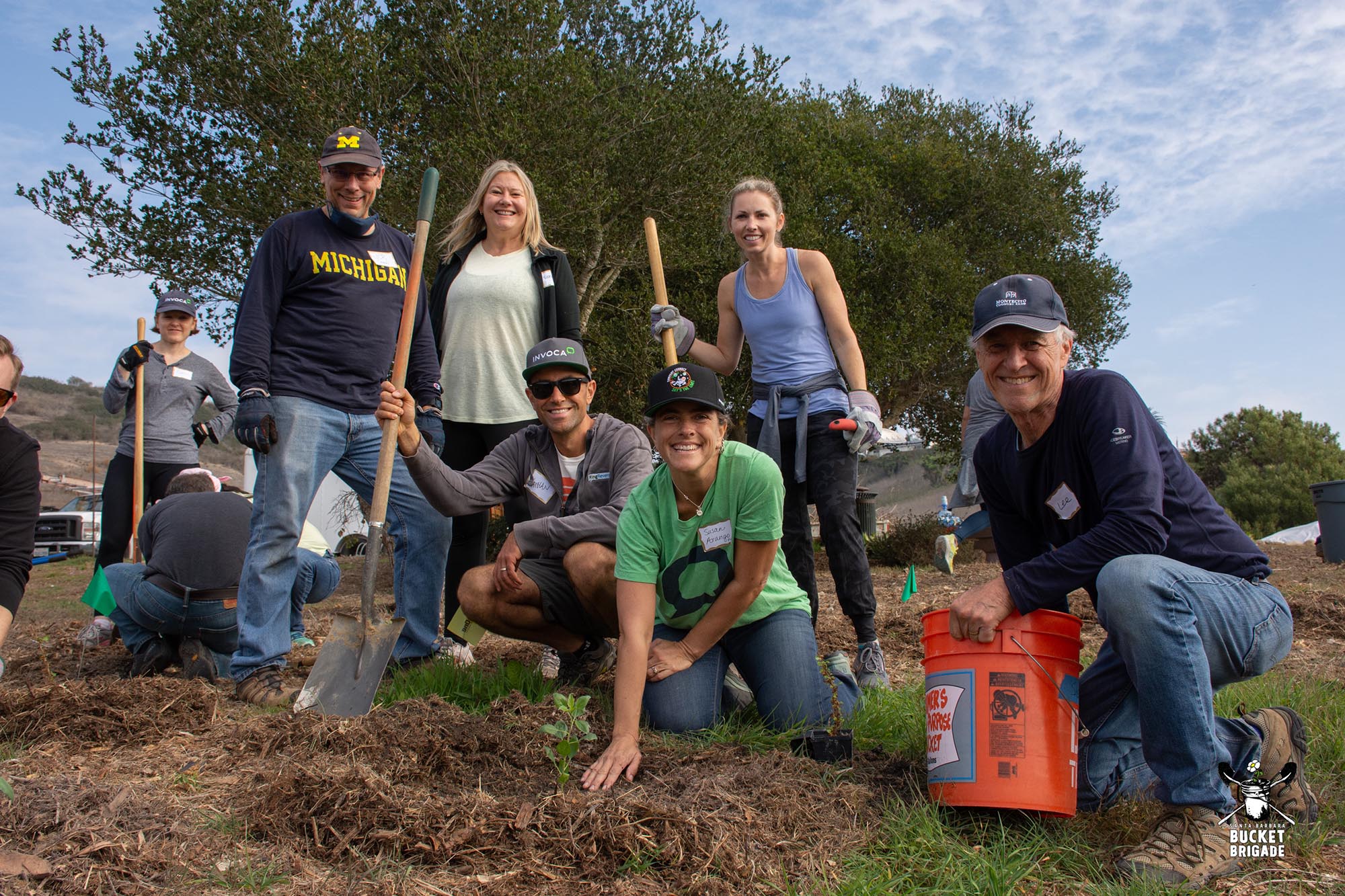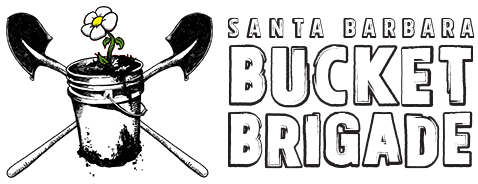Bucket Brigade Academy Advanced Volunteer Leadership Training in the Age of Climate Change
Bucket Brigade Humanitarian Garden
BUCKET BRIGADE HUMANITARIAN GARDEN
Addressing Food Insecurity While Growing Community Resilience
The Santa Barbara Bucket Brigade was founded to organize, train and deploy community volunteers in response to community crises. In Santa Barbara County today, one in four families experience food insecurity – the national average.The rate of food insecurity in Santa Barbara County is a persistent, ongoing crisis for over one hundred thousand of our neighbors. Climate change is only making this worse.
In response to the epidemic of food insecurity, the Santa Barbara Bucket Brigade has teamed up with the Elings Park Foundation and White Buffalo Land Trust to create the Bucket Brigade Humanitarian Garden.The Humanitarian Garden is a seven-acre plot at Elings Park which provides community access to fresh produce, gardening, and garden education while cultivating community engagement and improving access and equity in our city’s community garden program.

The Bucket Brigade Humanitarian Garden is designed to break down barriers to access by creating a space where anyone can enjoy the benefits of organic gardening in an easily-accessible location. The Humanitarian Garden is a place where garden volunteers can learn to grow using regenerative, organic farming practices while actively connecting with neighbors of all ages in an inclusive environment. All fresh produce grown and harvested will be donated to local food-aid organizations to reduce food insecurity.
The following information — developed with White Buffalo Land Trust for the Bucket Brigade— illustrates the specific needs and plans for the future of the Humanitarian Garden.
The Motivation
We have identified pathways to harness the true potential of this site to create a program that:
- Creates resilience in local food systems through demonstration of small scale food production
- Implements context specific agricultural practices to improve soil, biodiversity and watershed health at Elings Park
- Serves as a place for learning, demonstrating and communicating fundamental agricultural practices and principles

The Vision
The Bucket Brigade Humanitarian Garden will include raised beds and in-ground production of vegetables and fruits. There will be a planted buffer of mixed native and edible plants that provide beauty, nourishment and habitat around the garden. Plantings of deep rooted perennials will provide fire and drought resilience by rehydrating the landscape.

Site Design Considerations

A Community Hub: Located at Elings Park, The Bucket Brigade Humanitarian Garden will be accessible by some of the most densely populated areas in the California Central Coast. Elings Park is the largest community supported non-profit public park in America, and provides year round access to more than 200,000 visitors annually.
A newly installed bike path along Los Positas Road and nearby city bus stops make the location easily accessible to those walking, utilizing public transportation, riding electric or pedal bicycles, as well as by car.
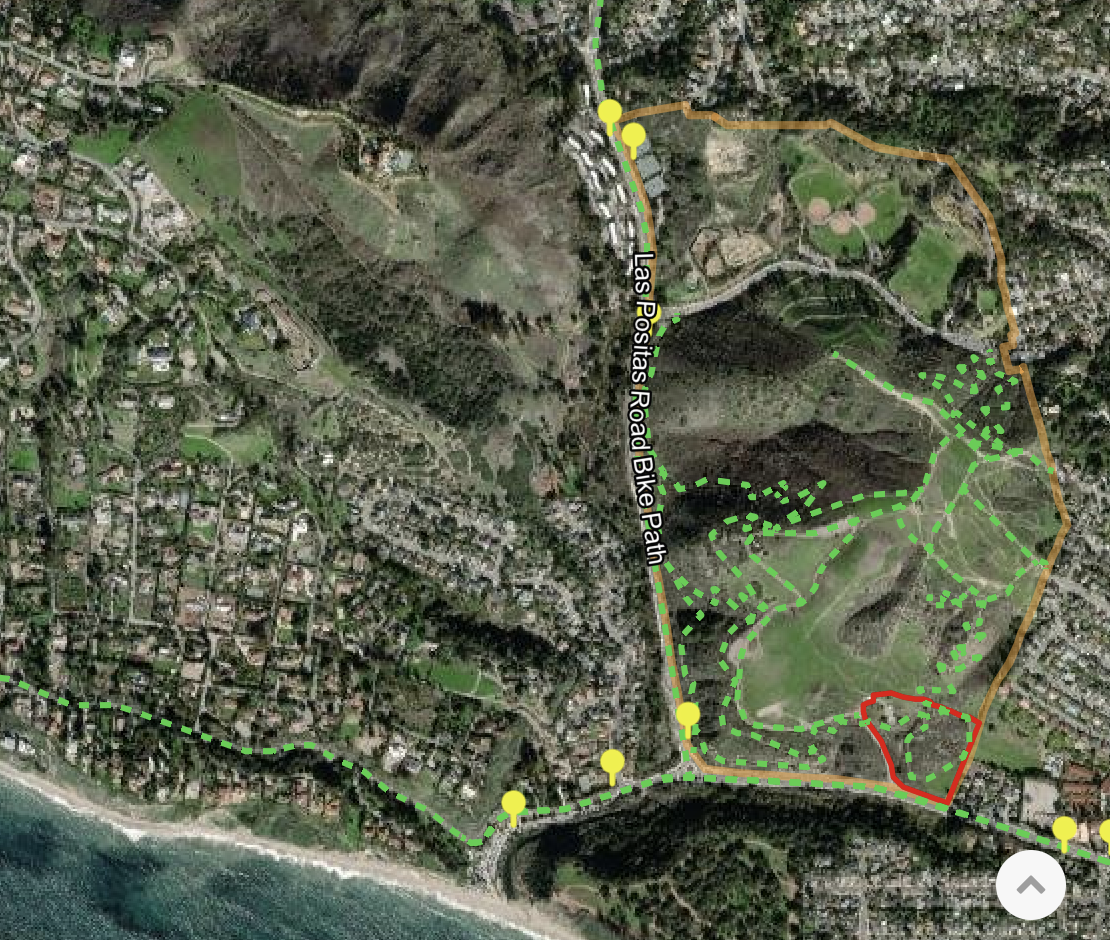
Due to its accessibility and centralized location, this site provides a unique opportunity to engage, demonstrate, and communicate the principles and practices of creating resilient food systems.
Climate
The local climate, soil, topography and water were considered in designing the Bucket Brigade Humanitarian Garden. Like much of Santa Barbara County, the site at Elings Park experiences a Mediterranean climate with warmer summers and colder winters. The proximity of this site to the Pacific Ocean allows the cool ocean breeze and marine fog to moderate its climate and temperatures.
Rainfall: Nearly all of the rainfall in this region is received during winter and early spring, with this site receiving an average of 14-16 inches of rain annually. Like elsewhere in California and the world, the impacts of a changing climate are already being felt in this region in the form of more frequent and prolonged droughts. While mean annual rainfall is expected to increase slightly in the coastal region of Santa Barbara County through the 21st century, so is the variability in rainfall That is, there is a higher likelihood of storms with higher rainfall totals, fewer total days with precipitation, and an increase in frequency and intensity of both droughts and flood events.

Therefore, while moderate temperatures create ideal conditions for cultivation year round, a high drought risk in the Santa Barbara area necessitates the need for crops and agricultural practices that are drought tolerant
Winds: The prevailing winds from the west will put constant pressure on any plantings on the western edge of the growing area, as well as the open area located along the southern road edge. Riparian tree plantings (such as Cottonwoods), hedgerow plantings, as well as the perennial orchards in the south-western end of the Community Resilience Garden will buffer the site from detrimental impacts of wind.

Soils: Bucket Brigade Humanitarian Garden consists of primarily two types of clay soils – Diablo Clay and Ayar Clay. Diablo Clay is the dominant soil layer and underlies all the food production zones in the garden. This soil was found to have good organic matter, but low microbial activity. These soils are classified as having a slow rate of infiltration when wet, which could result in large, erosive surface runoff after heavy rain events. Practices that feed and improve soil microbial activity will result in increased soil organic carbon, improved soil aggregation, improved infiltration and increased water retention. Such practices include compost, compost teas, mulch application and low tillage.

Ayar Clay is found along the southwestern boundary of the Bucket Brigade Humanitarian Garden. This region has high runoff potential due to its steep slopes, and can result in erosion and downstream sedimentation impacts. Planting deep rooted perennials upstream of this area and restoring vegetation along stream banks will improve water infiltration and reduce the amount of surface runoff.
Water: The Bucket Brigade Humanitarian Garden is located in a depositional zone, where sediments from the steep-sloped hillsides are deposited. Runoff from the hillsides drains to two hydrologic channels that connect at the northern boundary of the property and is then expressed as a steep sided arroyo that channels flow out through the south-western boundary. During an 1-inch rain event, the arroyo can receive 1 acre-feet (325,851 gallons) of runoff from a 13-acre watershed.

Given the steep slopes, and high runoff potential of the clay soils on this site (see Soils Section), an array of strategies will be used to maximize the potential of all water landing on site by creating a living sponge that can slow, spread, infiltrate, and retain water more efficiently. These strategies include:
- Increasing ground cover through a combination of mulch and vegetative cover to slow water
- Increase living and perennial roots in the ground to improve water infiltration
- Design access pathways to avoid channelizing water
- Not placing garden beds in areas where flowing water concentrates and erodes
- Water harvesting earthworks such as the orientation of plantings to match contours of the land
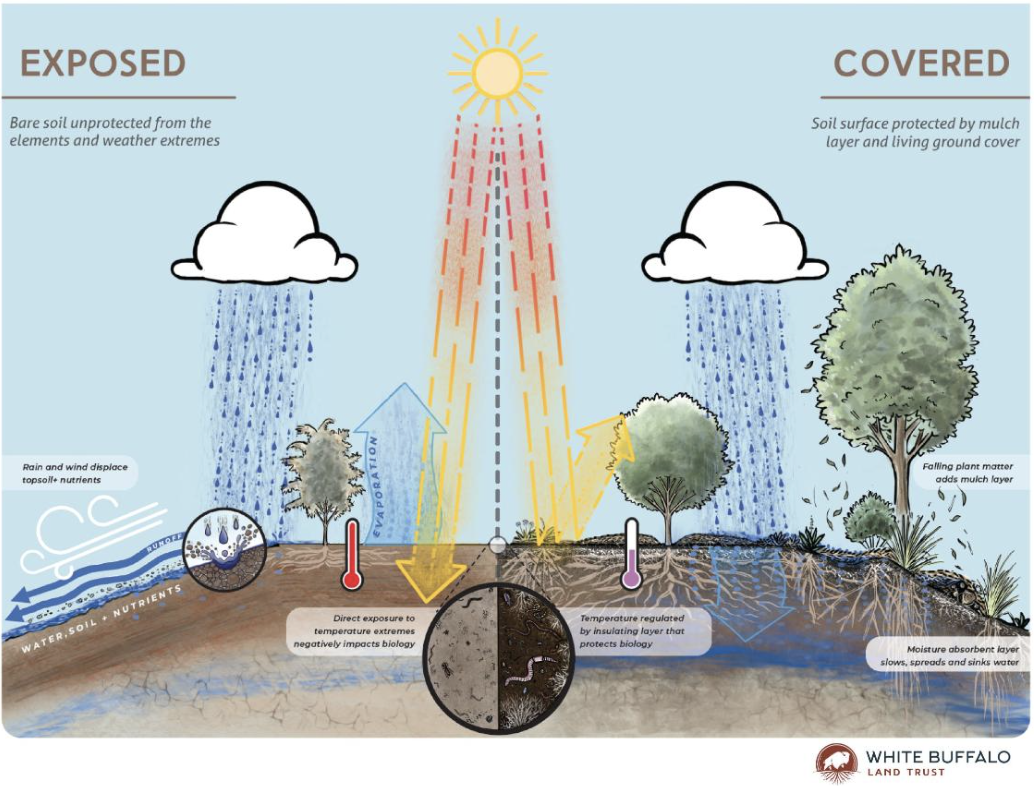

The current source of water for Elings Park, and for the Bucket Brigade Humanitarian Garden is City Water at a recreational rate. This water is channeled through a 2-inch source line, about 2400 linear feet from the water source to a riser that serves the garden. The reliance on City Water and a single water line can impact the resilience of this project from reduced water availability through drought or a disruption to the water line. It is recommended that in addition to drought tolerant plants, this project implements an irrigation design that reduces water use, in tandem with practices that aim to cover the soil surface and build soil fertility. This includes using drip lines around trees and in-ground plantings. We also recommend experimenting with innovative technologies that are context relevant, for example:
- Deep root irrigation in the orchard systems,
- Automated systems that respond to dry soils Blumat system in raised bed systems
- Subsurface irrigation systems in in-ground beds


Programmatic Zones
The cropping and vegetation system at the Bucket Brigade Humanitarian Garden has been designed to serve as a replicable model for a diversity of contexts. This includes choosing climate appropriate crops and practices, a mix of annual and perennial crops, raised bed production complimented by in-ground plantings and multi-strata agroforestry and soil building crop systems.
Main Access: The Bucket Brigade Humanitarian Garden can be accessed through a parking lot on the north-western boundary. This site will be utilized for an office space and a tool shed.
Access Pathways: Building on the existing and extensive network of trails in the area, new trails will guide visitors through the garden and its multitude of offerings. Visitors can explore and experience the hum of beneficial insects in a multi-strata, biodiverse food forest, enjoy the views and shade in a picnic garden, purchase native plants from the nursery or learn planting techniques in the S.E.E.D. zone.
Ease of Operation: The looped pathways are designed to enable flexible maneuverability, to allow for transport of materials to and from the materials drop off zone (in the parking lot) to the food production zones. These paths will enable ease of operations within the production zones when operating a small tractor, the maximum sized piece of equipment to be operated on site.

Picnic Garden: The picnic garden is the welcome area where guests can explore the garden through meandering paths in the sheltered shade of fruit trees, while enjoying an array of diverse plantings and fragrant flowers.

Nursery: The nursery will consist of a shaded structure, as well as an unshaded zone (“hardening area”) where plants can transition from a protected shaded or greenhouse environment to the harsh outdoor conditions of fluctuating temperatures, wind, and full sun exposure. The nursery will be focused on various forms of plant propagation, as well as a staging area for plants prior to planting. The potential for propagating plants on site will enable further expansion of plant stock, with added cost savings possibilities, as well as the potential for demonstrating an array of techniques and practices to community members.
Raised Bed Garden: A series of raised garden beds will focus on production of annual and experimental perennial food crops, such as culinary and medicinal herbs, as well as experimental perennial sensitive vegetables, as well as culinary and medicinal herbs. These gardens provide protection from gopher pressure.
Raised garden beds provide a demonstration of possible solutions for contexts without access to bare earth, providing models that can be replicated in urban contexts. Additionally raised beds provide more appropriate access to people with mobility disabilities.

Food Forest: A diverse food forest will explore the multiple layers within a high functioning natural forest ecology, including the overstory, midstory, understory, ground cover, vines, tubers, and fungus. This site can demonstrate the immense productivity potential of small spaces when each layer is strategically designed for access, maintenance, harvest and functional biological diversity.

Composting: Located by the parking lot, the composting area will serve as a material drop off and storage area for mulch, as well as a location for static, thermophilic, and worm composting systems.
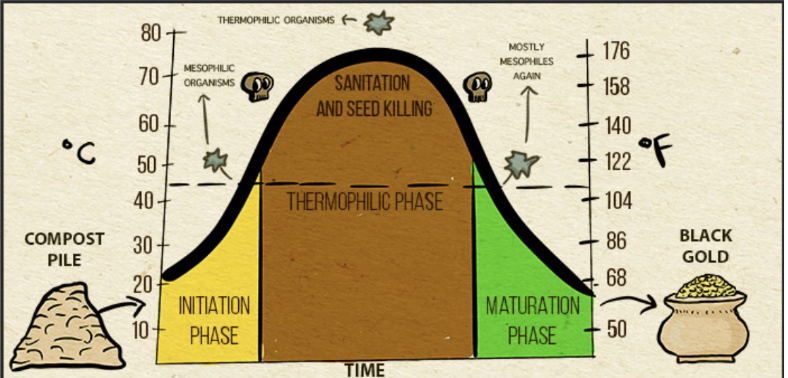
An aerated static composting pile system will allow for a steady trickle of organic material sourced from the on-site picnic area to be layered with carbon rich material (wood chips or sawdust), then forced or passive airflow can be used to activate the composting process.
A thermophilic composting pile will require regular maintenance and monitoring of temperature and moisture content, and tend to be more difficult to protect from disturbance from vermin and pets. Because of these constraints there should be a limited number of these piles used for demonstration purposes and should not be considered to be able to make up any significant portion of on-site compost needs in garden beds on orchards.

A vermicomposting system should be utilized as an important aid in decomposition of pre-processed organic material. To maintain a healthy environment in a worm composting system, it helps to preprocess the material to increase the surface area of the organic material. This can be accomplished by utilizing a garbage disposal system to grind food waste prior to adding to the composting bin or depositing in a static composting bin with and letting it decompose for a couple weeks prior to adding to the bin. The preprocessing through the garbage disposal provides the added benefit of increasing moisture content, which produces the ideal environment for biological (bacterial and fungal) decomposition.
The S.E.E.D. Farm (Stewarding, Environmental Education & Demonstration Farm) is the primary food production zone in the Bucket Brigade Humanitarian Garden. The 4 zones within the S.E.E.D farm described below are developed for optimal food production and community education

Gathering Zone: Strategically located with an expansive view of the S.E.E.D Farm zone, community groups visiting the site will have a large space to gather and learn about the various agricultural systems being demonstrated. Shade trees and a variety of plantings will create a unique sensory experience in this upper quadrant.
In-ground Planting Zones: This is the primary food production area with 3 blocks with in-ground food production systems. Each block will be divided into 4 sections and each section will have 10 beds measuring 50 feet in length for a total of 6,000 linear feet of beds and at a 30” width on each bed with 2ft spacing between beds amounting to 15,000 sq. ft. of bed space (total plantable area excluding access paths). Primarily focused on annual rotational cropping systems, there is additional potential to integrate in perennial and experimental cropping systems.

Perennial Orchard Zone: The establishment of an orchard system in the south-west will provide long term resilience through the deep perennial roots, the drought tolerance of dry Mediterranean adapted species, and the windbreak provided by the canopy for the annual in ground beds. Various planting models can be created to show the benefits of a range of different planting and management principles and practices. Suitable species for this context include Figs, Persimmons, Kumquats, Lemons, Oranges, Tangerines, Pomegranates and Apricots. Orchard species will be planted in 10 rows along landscape contours. The rows range between 25 – 200ft, measuring a total of 740 linear feet.

Companion Plantings: Orchard systems will be planted with ‘companion species’ that cover and build soil, add nutrients to soil, attract beneficial insects and pollinators and improve harvest capacity in the form of culinary/medicinal herbs, vegetables and leafy greens, cut flowers, tubers, and mushrooms.
Cane Fruit Zone: Cane fruits such as Thornless Blackberry, Raspberry, and Grapes can be planted with support systems, or shaped to grow over arbors or trellis systems such as archways/tunnels.
Additionally, Fence Line Plantings surrounding the Nursery, Raised Bed Garden, Food Forest and S.E.E.D. farm line can be utilized to support vining plants that provide food, shelter, and pollination services. Passionfruit is an excellent vining plant to be grown along fence lines. It will provide multiple benefits such as fruit, habitat for pollinators, and added medicinal value from its flowers.

Building Ecological Literacy: An educational kiosk on eastern end of the park will welcome visitors from the neighboring elementary school and other visitors to the garden, and engage with the community on agriculture and native habitat restoration.
PHOTO: An educational board donated by a local artist that depicts what a food forest is. Source: Beacon Hill Food Forest, WA. © Jonathan H. Lee
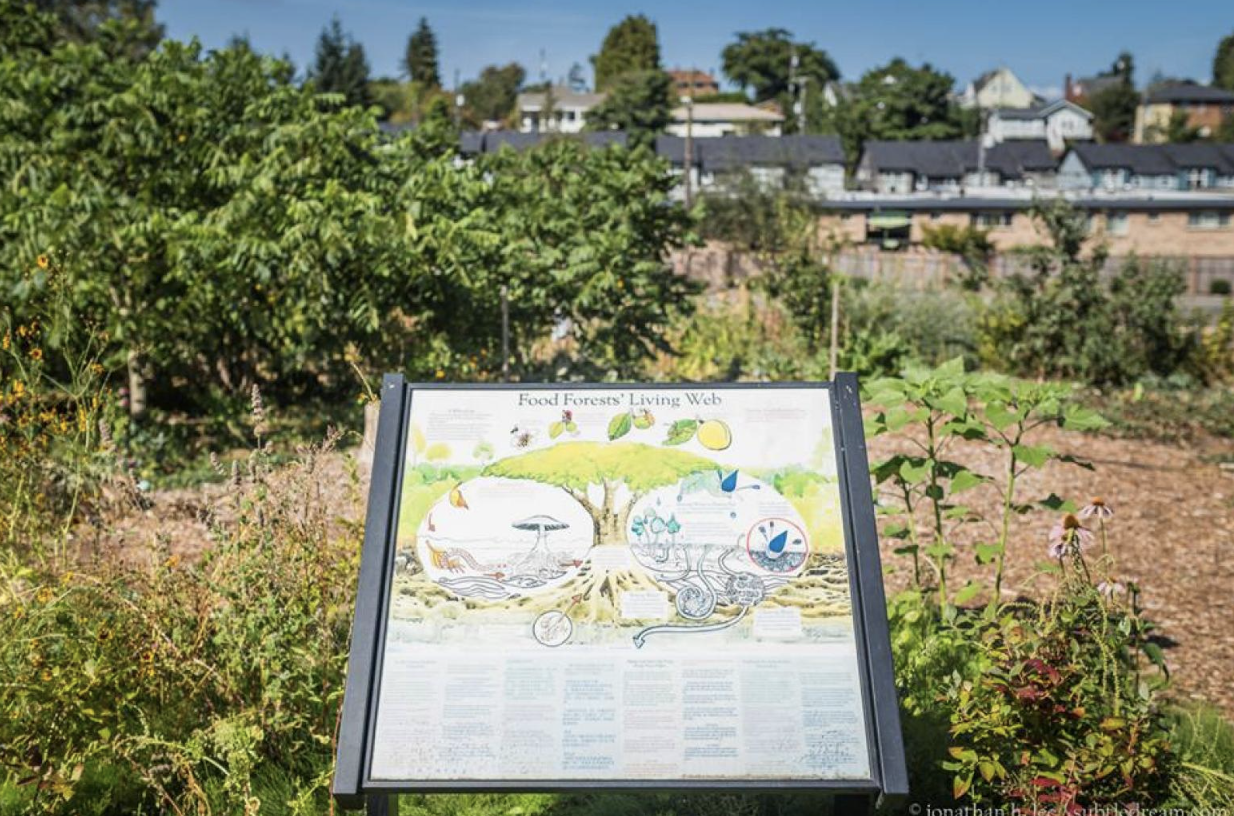
Tree & Shrub Buffers: The buffer plantings that surround the S.E.E.D. zone will provide a visual and access barrier while also providing habitat for beneficial species as well as additional productive possibilities.
There are few high value native shrubs and trees (such as Lemonade Berry, Coffee Berry & California Sagebrush) that provide a series of co-benefits for the project site including habitat to birds and pollinators which are integral to the nutrient cycling and on-site pest management. These will be integrated into the buffer zone.
In addition to the existing vegetation, a wide range of additional native plantings, as well as non-native drought tolerant plantings (such a Pineapple Guavas, Maximilian Sunflower, Mesquite, Rosemary, Lavender) can also be incorporated into the buffer zone to expand habitat, attract beneficial species, aid in nutrient cycling and water infiltration, all while offering edible, medicinal, and/or other productive elements that require minimal maintenance.
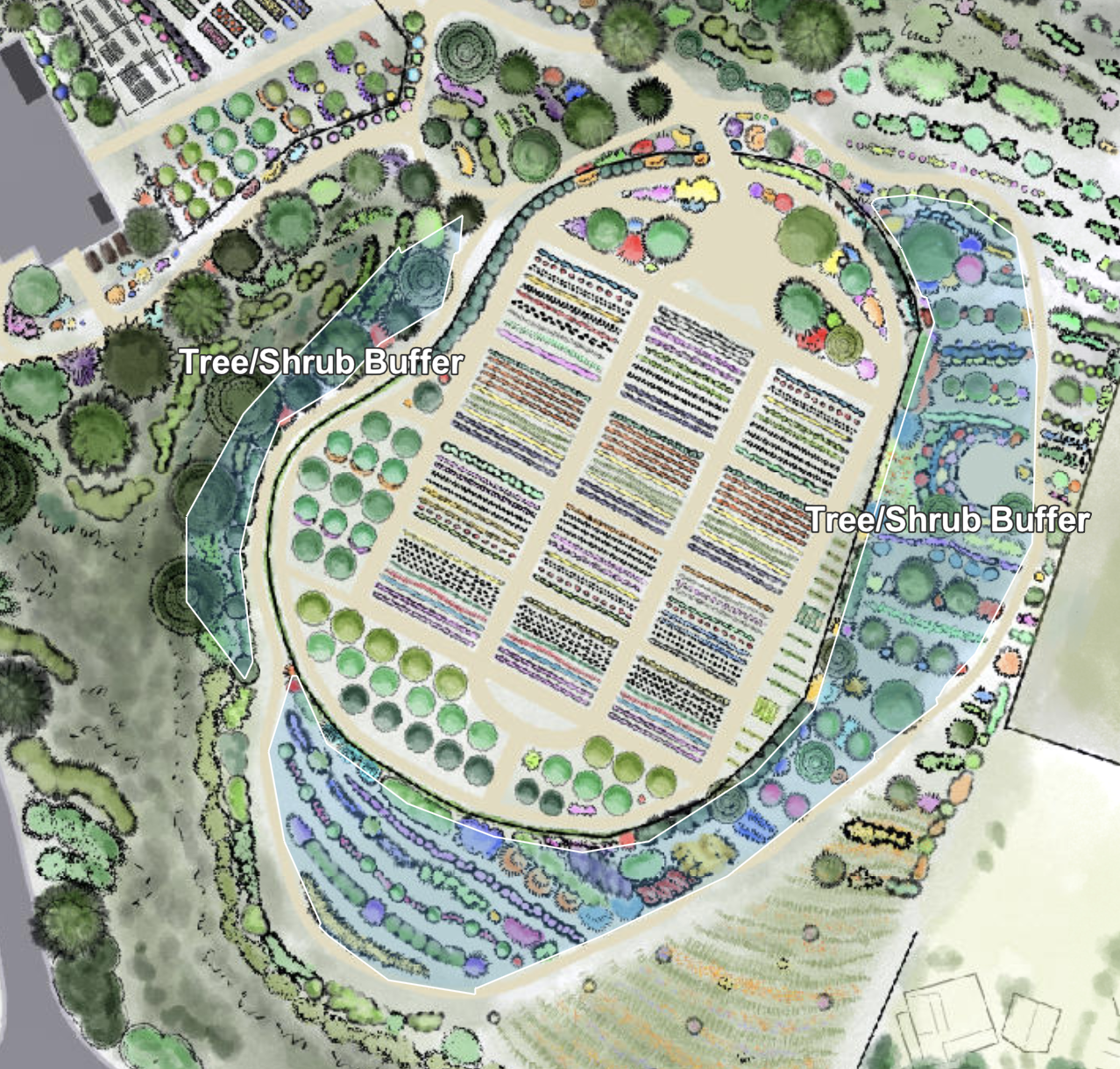
Meadow: An existing swath of land to the south east of the plot, consisting of native grasses, this meadow could be a habitat for native pollinators, birds and insects through the seeding and planting of plugs and small potted plants in order to create a diverse grass, forbe, legume ground cover.
PHOTO: A meadow in bloom. Source: Tricia Wardlaw/Courtesy of SBBG

Restoration: Through the establishment of native plantings suggested by the restoration ecologists at the Santa Barbara Botanic Garden, in conjunction with micro earthworks that establish contour designed swales and basins in order to mitigate the erosive nature of heavy rain events and distribute water coming out of the steep sloped arroyo / gully into the alluvial deposition zone, we seek to increase the hydrological function of the project area, and provide more healthy perennial subsurface water flow through the spring line at the southern point in the project area. Any removal of native vegetation from the S.E.E.D. area would potentially be utilized as plant stock for restoration projects.
Riparian Restoration: Strategic plantings and restorative management practices in riparian corridor will help recharge groundwater aquifers and replenish the localized spring. Species such as Lemonade Berry will help stabilize the steep slopes of the arroyo, and Cottonwood tree plantings will additionally provide a wind buffer to the adjacent S.E.E.D. zone.

Dryland Firebreak Planting: Fire resistant species of trees and shrubs will be planted along the contour lines of the slope to provide erosion control on the steep slopes, rehydrate the landscape and also act as a firebreak for the garden and the neighboring community.
Succulents are adapted to arid climates and are fire resistant as they store water in their leaves, have low levels of oils and resins, limited dead materials, as well as high salt levels. We recommend the use of succulent species such as Opuntia, Agave americana, Agave mapisaga, Aloe vera, Aloe arborescens, Cereus repandus.
PHOTO: Opuntia or the Prickly Pear cactus is adapted to arid climates, fire resistant and provides edible fruits.

Get Involved Today!
The Bucket Brigade Humanitarian Garden is a one-of-a-kind project. If you are interested in helping us transform a hillside of invasive weeds into a beautiful, nutritious, and educational garden for the whole community, we need your help!
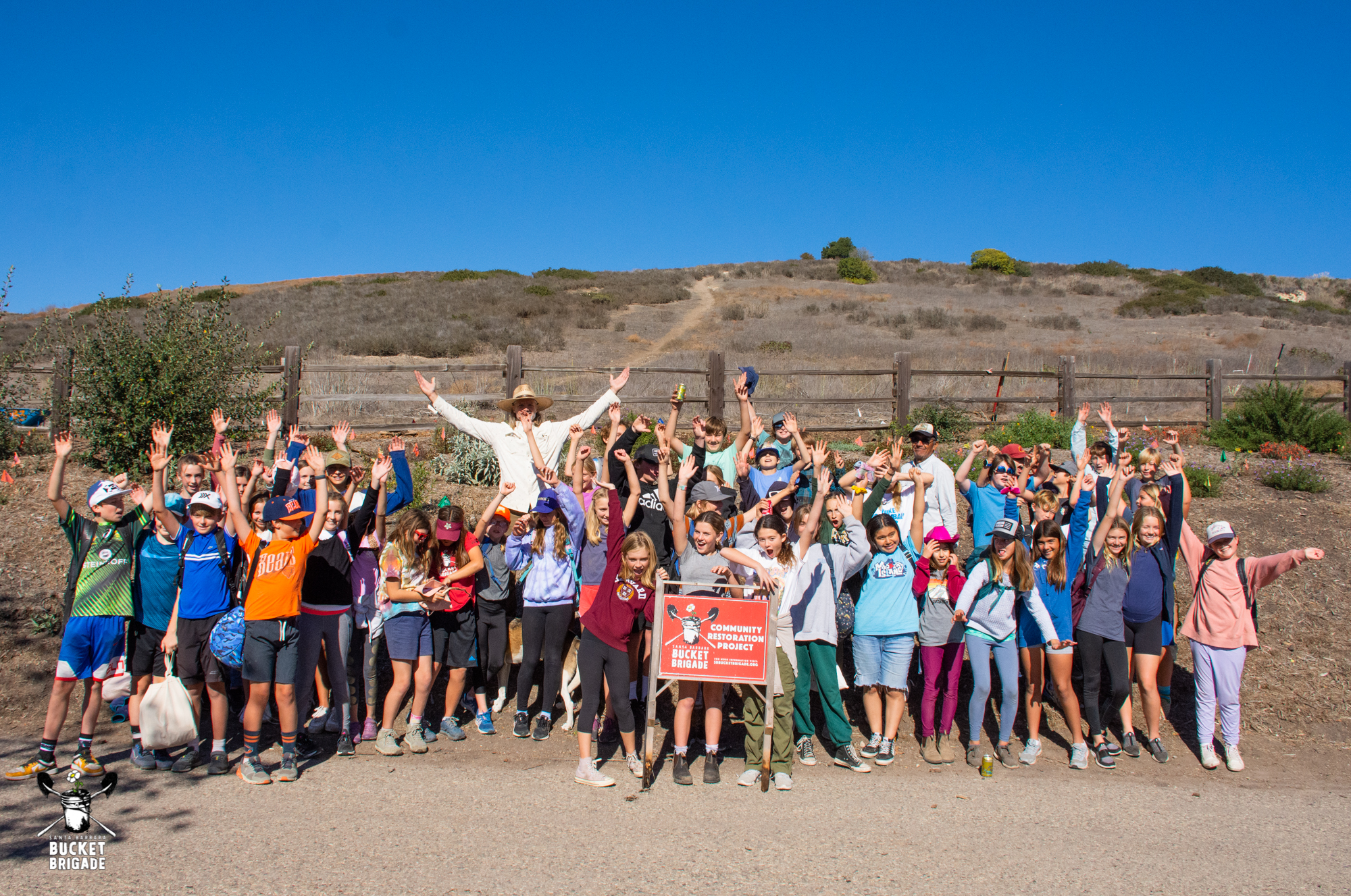
Donate: Gifts to support the Garden can be made in the following ways:
- By check made out to Santa Barbara Bucket Brigade “attn. Bucket Brigade Humanitarian Garden” and mailed to: Santa Barbara Bucket Brigade P.O. Box 50640 Santa Barbara, CA 93150.
- By Online Donation here
- By Direct Deposit/Wire Transfer.
- Multi-Year Gifts

Volunteer: You can sign up to volunteer in the garden right now! Please visit bucketbrigade.volunteerhub.com and find a garden event that fits your schedule. We have weekly volunteer opportunities, so get your hands dirty planting, digging, connecting, and more. Volunteers are an essential part of this campaign and we can’t do this without you.

Sponsor: Do you love the Food Forests? Maybe the Picnic Garden speaks to you! Consider sponsoring your favorite section. Sponsors will be recognized with a plaque at that section of the garden. Sponsorships leave a lasting legacy for future generations to enjoy and benefit from. Please contact us at contactus@sbbucketbrigade.org if you love a certain section of the garden and would like to sponsor it.

Email contactus@sbbucketbrigade.org to set up Multi-Year Gifts and Direct Deposit/Wire Transfer Donations.

Advocate: Do you live on the Mesa or near Elings Park? Do you love gardening, our community, regenerative farming practices, and helping reduce food insecurity in Santa Barbara? Please help us share the news about the Bucket Brigade Humanitarian Garden! We can provide you with links, photos and literature to give to family, friends, and neighbors and to share on social media.
